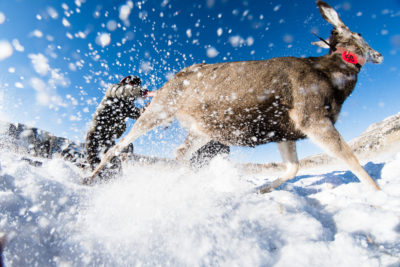 Although migration may be the most optimal strategy in numerous ungulate systems, many migratory herds contain individuals that do not migrate or migrate relatively short distances – a phenomena known as partial migration. If long-distance migration, however, is commonly viewed as the most profitable strategy promoting herd fitness and population performance, what allows residents – or other strategies – to persist over the long-term?
Although migration may be the most optimal strategy in numerous ungulate systems, many migratory herds contain individuals that do not migrate or migrate relatively short distances – a phenomena known as partial migration. If long-distance migration, however, is commonly viewed as the most profitable strategy promoting herd fitness and population performance, what allows residents – or other strategies – to persist over the long-term?
Wildlife biologists are beginning to understand that a diversity of migratory tactics may sustain herd productivity, particularly when strategies are exposed to intermittently poor environmental conditions (i.e., severe winters, summer drought). Annual shifts in relative benefits of migration among strategies – often described as the fitness-balancing hypothesis – may be key to minimizing dramatic population fluctuations that are challenging for managers and biologists to predict and adapt to.
We are studying a diversity of migratory strategies in a partially migratory herd of mule deer sharing a common winter range in the Red Desert of south-central Wyoming. Through monitoring of movement with GPS collars, we have been studying the world’s longest mule deer migration and also the longest big game migration yet recorded in the Lower 48: a deer herd that travels 150 miles from its winter range in the Red Desert to its summer ranges in the Hoback and Upper Green River Basins. In 2018, we discovered a 242-mile journey of Deer 255 from her winter range in the Red Desert near Superior, WY to her summer range near Island, Park ID – a new record-breaking migration previously unknown to this herd.
 These long-distance migrants are one of three migratory strategies that we have observed within this portion of the Sublette Mule Deer Herd. The other two strategies include medium-distance migrants that migrate nearly 70 miles to the southern Wind River Range for the summer, and short-distance migrants that either travel less than 30 miles north or remain year-round as residents in the Red Desert. Although these different types of migration have been observed for several years, little is known about costs or benefits associated with each migratory strategy and how a diversity of migratory tactics benefits the productivity of the overall herd. Evaluating different migratory tactics in the Sublette Herd is an important step in understanding factors maintaining variability in migration behavior and will aid in future conservation and management efforts.
These long-distance migrants are one of three migratory strategies that we have observed within this portion of the Sublette Mule Deer Herd. The other two strategies include medium-distance migrants that migrate nearly 70 miles to the southern Wind River Range for the summer, and short-distance migrants that either travel less than 30 miles north or remain year-round as residents in the Red Desert. Although these different types of migration have been observed for several years, little is known about costs or benefits associated with each migratory strategy and how a diversity of migratory tactics benefits the productivity of the overall herd. Evaluating different migratory tactics in the Sublette Herd is an important step in understanding factors maintaining variability in migration behavior and will aid in future conservation and management efforts.
Contact
Matt Kauffman
mkauffm1@uwyo.edu
307-766-6404
@wyokauffman
Anna Ortega, PhD Candidate
aortega5@uwyo.edu
Project Lead
Anna Ortega graduated with a PhD from the Wyoming Cooperative Fish and Wildlife Research Unit and the Department of Zoology and Physiology in 2023. She was born and raised in Durango, Colorado—a small southwestern town located in the valley below the high alpine tundra of the San Juan Mountains. MORE »

